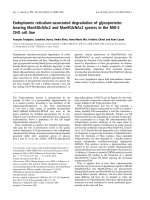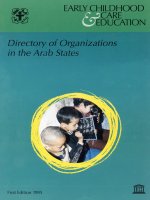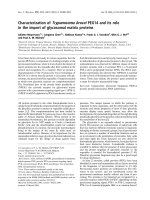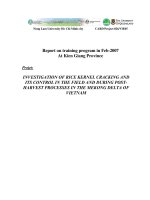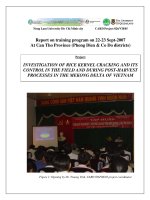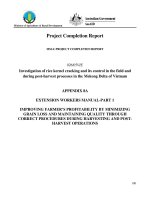shadows of war violence power and international profiteering in the twenty-first century
Bạn đang xem bản rút gọn của tài liệu. Xem và tải ngay bản đầy đủ của tài liệu tại đây (3.55 MB, 308 trang )
SHADOWS OF WAR
CALIFORNIA SERIES IN PUBLIC ANTHROPOLOGY
The California Series in Public Anthropology emphasizes the anthro-
pologist’s role as an engaged intellectual. It continues anthropology’s com-
mitment to being an ethnographic witness, to describing, in human terms,
how life is lived beyond the borders of many readers’ experiences. But it
also adds a commitment, through ethnography, to reframing the terms of
public debate—transforming received, accepted understandings of social
issues with new insights, new framings.
Series Editor: Robert Borofsky (Hawaii Pacific University)
Contributing Editors: Philippe Bourgois (UC San Francisco), Paul Farmer
(Partners in Health), Rayna Rapp (New York University), and Nancy
Scheper-Hughes (UC Berkeley)
University of California Press Editor: Naomi Schneider
1. Twice Dead: Organ Transplants and the Reinvention of Death,
by Margaret Lock
2. Birthing the Nation: Strategies of Palestinian Women in Israel,
by Rhoda Ann Kanaaneh (with a Foreword by Hannan Ashrawi)
3. Annihilating Difference: The Anthropology of Genocide, edited by
Alexander Laban Hinton (with a Foreword by Kenneth Roth)
4. Pathologies of Power: Structural Violence and the Assault on Health and
Human Rights, by Paul Farmer (with a Foreword by Amartya Sen)
5. Buddha is Hiding: Refugees, Citizenship, and the New America, by Aihwa Ong
6. Chechnya: The Making of a War-Torn Society, by Valery Tishkov
7. Total Confinement: Madness and Reason in the Maximum Security Prison,
by Lorna A. Rhodes
8. Paradise in Ashes: A Guatemalan Journey of Courage, Terror, and Hope,
by Beatriz Manz
9. Laughter Out of Place: Race, Class, Violence, and Sexuality in a Rio
Shantytown, by Donna M. Goldstein
10. Shadows of War: Violence, Power, and International Profiteering in the
Twenty-First Century, by Carolyn Nordstrom
SHADOWS OF WAR
VIOLENCE, POWER, AND INTERNATIONAL PROFITEERING
IN THE TWENTY-FIRST CENTURY
CAROLYN NORDSTROM
UNIVERSITY OF CALIFORNIA PRESS
BERKELEY LOS ANGELES LONDON
University of California Press
Berkeley and Los Angeles, California
University of California Press, Ltd.
London, England
© 2004 by the Regents of the University of California
Library of Congress Cataloging-in-Publication Data
Nordstrom, Carolyn, 1953–.
Shadows of war : violence, power, and international profiteering in the
twenty-first century / Carolyn Nordstrom.
p. cm.—(California series in public anthropology; 10)
Includes bibliographical references and index.
isbn 0–520-23977-6 (cloth)
1. War and society. 2. War—Economic aspects. 3. Informal sector
(Economics) I. Title. II. Series.
hm554.n67 2004
303.6'6—dc22 2003060803
Manufactured in the United States of America
13 12 11 10 09 08 07 06 05 04
10987654 321
The paper used in this publication meets the minimum requirements of
ansi/niso z39.48–1992 (r 1997) (Permanence of Paper).
For Patricia Churchill
who told me when I was five
that I could go anywhere I wanted.
The Vagabond’s House . . .
CONTENTS
Acknowledgments xi
PART ONE: INTRODUCTIONS 1
1. Prologue 5
2. A Conversation in a Bar at the Front 19
3. Making Things Invisible 25
PART TWO: WAR 41
4. Finding the Front Lines 45
5. Violence 55
6. Power 71
PART THREE: SHADOWS 83
7. Entering the Shadows 87
8. A First Exploratory Definition of the Shadows 105
9. The Cultures of the Shadows:
The Meat, Potatoes, Diamonds, and Guns of Daily Life 119
PART FOUR: PEACE? 139
10. The Institutionalization of the Shadows:
(Habits of War Mar Landscapes of Peace) 143
11. The Autobiography of a Man Called Peace 157
12. The Time of Not-War-Not-Peace 165
13. Peace 175
14. The Problems with Peace 187
PART FIVE: DANGEROUS PROFITS 205
15. Ironies in the Shadows: (Literally) Untold Profits
and a Key Source of Development 209
16. Why Don’t We Study the Shadows? 225
17. Epilogue: Two Sides of the Same Coin 239
Postscript: The War of the Month Club—Iraq 245
Notes 251
Bibliography 273
Index 283
In 1996 when I was traveling in Southern Africa for a year and a half, I
began a novel about a young war orphan. The first page opened by say-
ing that the story was true, but the only way to tell a true war story was
in fiction. The novel allowed me to write down what academia had few
solutions for: writing real stories of real people without getting them, or
me, into danger. In the intervening years, academia has become more open
to writing that requires special sensitivities and responsibilities, and I have
become more practiced in telling a war story without giving the prover-
bial “name, rank, and serial number.”
My acknowledgments are thus more important, and more difficult, as
I cannot directly thank in print most of those who made this book pos-
sible. This book is about warzones and illicit economies: my fieldwork is
populated with the hopeful and the hopeless, torture victims and tortur-
ers, rogues and thieves, smugglers and heroes, the terrified and the pow-
erful. Most do not want their names in print. These people sat down and
opened their homes and their lives to me, shared their ideas and their food,
and trusted me with their stories. This book chronicles many of them,
sans names.
Many went out of their way to tell me their stories. The autobiogra-
phy of a man called Peace in this book is a good example. Peace came up
to me one day on the road and asked me for a camera. I first met Peace
when he was a youth on the streets, but did not know him well. Now he
was a full-grown man who looked as hard as the streets on which he slept.
I hesitated a moment, wondering if I should go to the “markets” (as the
book shows, the “unavailable” in a warzone is always available in some
market, however far from any definitions of legal it may be) to get a cam-
xi
era for Peace. I decided that no matter what he did with the camera—
from selling it to taking pictures—it was a story. Peace was waiting for
me at the break of dawn the morning after I gave him a camera. He had
spent the entire night walking the streets of the city taking pictures. He
handed me the camera and said, “I want people to understand the suf-
fering of those of us who live in war and on the streets—the real suffer-
ing.” At risk to himself, he had taken pictures of police beating street
youth, kids smoking crack, prostitutes serving the powerful, gaunt hun-
gry preteens rummaging for a scrap of food in dumpsters—the stories of
night. On his own initiative, he had interviewed many of these people
and written up their biographies to accompany the photos. Why would
a man who most see as a dangerous street thief do this? Perhaps because
he cares. The most important thing I have learned from my research is
that even the worst violence cannot extinguish the spark of humanity in
most people. As powerful as Peace’s story is for me, for his own protec-
tion I have deleted all references in his autobiography that can identify
him. It is Peace, and all the people like him in this book, that I most want
to thank.
There are some I can name. This research would not have been possi-
ble without a year-and-a-half grant from the John T. and Catherine C.
MacArthur Foundation. I want to thank them for extending a grant to
research that broke with the traditional, a grant that allowed me to cross
conceptual, political, and continental borders in following the flows of
people and goods that populate this book.
I am also grateful to the United States Institute of Peace: my work on
extra-legal economies first began several years ago with a year-and-a-half
grant from USIP that allowed me to do comparative ethnographic work
on warzones in several countries. The Institute for International Studies
at the University of California, Berkeley, provided me with an institutional
home during this research.
The University of Notre Dame supported this research with both
grants and generous sabbatical time; my colleagues kept the proverbial
candle burning in the window for me. University Eduardo Mondlane in
Mozambique and the University of Witswatersrand in South Africa
extended institutional and collegial support. I want to thank Debi LeBeau
for the amazing road trips, Ana LaForte for her good advice, Joel Chiziane
for his insights into war, Marissa Moreman and Leandro Lopes for their
unwavering help and companionship, Alexander Aboagye for his assis-
tance in understanding non-formal economies, Casimira Benge and Lidia
Borba for their warm assistance in Angola, Crystal Prentice for being an
xii ACKNOWLEDGMENTS
excellent research assistant, and Katia Airola, Alex Laskaris, Mary Pat Sel-
vaggio, Carole Swayne, Justin Wylie, and Sonja and John McKenna and
all the people at The Cottages, for opening their homes and stories to me.
Equally important, my sincerest thanks go to the pilots who ferried me
endless miles in Africa and to the people at AfricaCare, Concern, Médecins
Sans Frontières, Save the Children, Christian Children’s Fund, UNICEF,
International Committee of the Red Cross, InterOcean, Halo Trust, and
the UN, who welcomed me into their homes, their jobs, and their par-
ties in some pretty war-torn locales. These are the people who let me sleep
on their office floors in out-of-the-way locales, who graciously share their
last potatoes with me, and who take me out into their field sites—where
they work, often at considerable risk to themselves, far from the praising
light of CNN cameras and official recorders. The epilogue is dedicated
to them. And my warmest thanks to Leela, who disappeared into war one
day, but taught me how to fight back.
Finally, I’d like to thank the people who made this book possible:
Naomi Schneider and Rob Borofsky: may their dreams for a vibrant new
anthropology come true. And may all authors have such a good time at
meals with their editors.
Photo credits: All the photos in the book are mine—they are a testi-
mony to anthropology at its best and rawest: taken with street-market
cameras in conditions where cameras are seldom welcome, and developed
on the road in local conditions. They are stories in themselves.
ACKNOWLEDGMENTS xiii
PART 0NE
INTRODUCTIONS
Wars and illicit economies make strange bedfellows. War’s shadows cast
widely; and in the areas of poor illumination lives and fortunes are forged
and lost. As nations grow and crumble under the banners of progress and
the weight of violence, each citizen tells or paints or dances or bleeds his
or her story of survival. The sum total of these stories tells us the nature
of war and the prospects for peace. Few reach the light of international
recognition, most are lost in the shadows.
Ethnography is a discipline sophisticated in its simplicity: it travels with
the anthropologist to the front lines and across lights and shadows to col-
lect these stories; to illuminate strange bedfellows, and, if one were to
put it bluntly, to care.
This book is dedicated to collecting stories of war, peace, and illicit
economies across people’s lives, and across zones of war and peace in dif-
ferent countries and on different continents. Neither the stories nor the
ethnographies of the twenty-first century are bound to single locales: what
patterns ripple across cultural landscapes, sovereign borders, and theo-
retical domains? As an arms merchant steps on an airplane to fly from one
warzone to another, he or she hears a gunshot, a victim falls, a story
unfolds. As the merchant steps off the plane a continent away, he or she
notices another gunshot. What patterns of politics, of economics, and of
personal heroism and tragedy define our world in the intersections of
power, profit, survival, and humanity—in the shot of a gun? What expe-
riences from the front lines of wars and the back lines of profiteering bring
these understandings to life?
3
PROLOGUE
These people say that war is a crocodile which is always
hungry. It has dishonest eyes and a thrashing tail. It creeps
up quietly while you wash at the river, while you pound your
corn, while you rock your old mother in her time of dying.
It is with you always, war, waiting to explode your life
and throw you down beside a river to die. War wants death,
always; war wants to quiet your mother’s songs. War wants
your sorrow.
1
5
War is one of those impossible words: it refers to war as a soldier in Sudan
lives it, as a child in Sri Lanka experiences it, as a torture victim in
Argentina’s dirty war felt it, as a Greek in Troy died it. A mere three let-
ters covers a sweep of hundreds of thousands of events across several mil-
lennia. How do we understand so vast a phenomenon while retaining the
vibrancy of the lives that constitute it?
There is an image of war that has stuck in my mind for nearly two
decades. It seems to point toward some deep understanding, something
that stands just outside of conscious grasp, or maybe beyond intellectual
thought to a more profound conception of . . . what? Not just war, but
something that tugs at the heart of what it means to be human. And in
the curious combination that links devastating disasters with the pro-
foundly mundane, this image involves a watermelon amid some of the
worst violence marking recent decades. A Sri Lankan acquaintance and I
had traveled to the July 1983 Kataragama religious festival in southeast-
ern Sri Lanka. She is a middle-aged woman from the capital city of
Colombo, a mother with a ready laugh and a maternal charm that holds
a bit of impishness. We had shared a room, and I remember her unpack-
ing her travel bag the first day; she had a towel, food, and other useful
items I had not thought to pack. She laughingly lectured me: “Carry what
you will need.”
The 1983 riots in which thousands were killed in seven days broke out
the last night of the festival.
2
No one knew the violence was about to erupt
as they said goodbye to one another and began their journeys home.
Almost no one: curiously, the last two evenings of the festival several of
the homeless “mentally ill” people spoke at length and with great emo-
tion about the impending violence. One directed his agitated monologue
at me, perhaps because I was a foreigner. As a large crowd gathered around
us, he launched into an aggressive explanation of the cataclysmic violence
that was soon to erupt, the blood that would stain the streets and homes
of the country, the screams of pain and anger he could hear, and the ways
in which the responsibility for this violence went all the way to my coun-
try in cycles of global inequality. The audience around us sought to brush
off his belligerent words with a reference to his madness, but a troubling
clarity in his speech unsettled all of us.
Just before my traveling companion and I left Kataragama, she found
a large watermelon, and bought it to take home to her family. She tried
to give me a hug as we parted company to travel to our respective homes
and broke out laughing as she juggled her suitcase in one hand and the
watermelon in the other.
The bus she took to Colombo arrived at a city overtaken by flames and
overrun by mobs. The next time I saw her, she told me of that night:
We left the Kataragama festival that is meant to put the world together and
arrived home to find the world being taken apart. We arrived to a nightmare
worse than any the mind could conceive in dream. As we took the bus out
of Kataragama, night began to fall, and we were lulled to sleep by the rock-
ing of the bus, the camaraderie of sharing food, and warm memories of the
festival. Sometime after midnight as we began to near Colombo, we opened
our eyes to a world gone mad. Entire blocks of buildings were in flames,
and people broke out of these buildings aflame themselves. Buses and cars
burned in the roads, some with the occupants locked inside. Crowds of
people ran in the streets, some shouting and beating people, overturning
cars and setting them on fire, attacking homes and businesses others
running for safety and for their lives. Nothing made sense. As buses were
being stopped, passengers being hauled out and killed, and the vehicles
firebombed, our bus driver stopped suddenly and turned all of us passen-
gers out onto the street, and drove away. It was nowhere near the bus ter-
minal, and none of us knew where we were.
6 PART ONE: INTRODUCTIONS
This fact startles me to this day: I grew up in this city, I know it as home;
I know its streets and alleys, its shops and landmarks. I know my way around
by a lifetime of knowledge—the pretty wall Mr. Wickramasingham built on
this corner, the funny shaped tree in the open field by Mrs. Dharmaratna’s
shop, the temple my friend took her child to when he fell ill, the movie the-
atre painted bright blue. But that night, I didn’t know where I was, or how to
get home. I didn’t recognize the city I spent my whole life in. Even that isn’t
really true: it tore such a cruel wound because I recognized it and I didn’t,
all at once. Amid the familiar was such horror. Those pretty walls and funny
trees, the shops and temples, were in flames or destroyed, the dead and
wounded lay there now, and mobs seemed to appear from empty space,
overpower all reason, and disappear again, only to be replaced by another
just down the road. The police did nothing, or maybe they did too much.
I had all my belongings from my trip with me, my handbag, my wrap, my
suitcase, and that large watermelon. I just set my feet moving and tried to
find my way home. Every street I turned down seemed as unfamiliar as the
last. The horror never stopped. Fires, mobs, beatings, murder. I was ex-
hausted, and my mind could not grasp what it saw. Nothing was clear: not
who was killing whom, nor why. Not where it might be safe nor how to get
there. Not how to respond nor whom to turn to, and no way of finding out.
I walked for hours. I grew painfully tired, and the things I was carrying
seemed to weigh more and more. At some point, I stopped and set my hand-
bag down on the sidewalk and left it there. It just seemed too much to carry.
A while later I took my wrap and wiped the sweat and soot off my face, and
left the wrap there on someone’s fence as I picked up my suitcase and that
watermelon and trudged off again in search of my home. Somehow in my
mind I thought I’d go back and collect my handbag the next day—I really
thought it would just be sitting there where I left it. That’s how hard it is to
think realistically when everything around you is unrealistic. I left all my iden-
tification, my money, everything sitting there on the road while I carried off
that heavy unwieldy watermelon with me. Sometime later, it might have been
hours or days to my mind, the suitcase became unbearably heavy, and I set
that down too and left it. But I never let go of that watermelon. To this day,
I can’t explain it. But I carried that watermelon all night long through all the
chaos and horror, and finally arrived home clutching that darned thing, hav-
ing left everything else on the road.
You know, my handbag had all my necessities in it: my identification, my
money and bank cards, my glasses and licenses. My suitcase had my favorite
saris, my daily necessities and medicines, and presents and blessed reli-
gious relics for my family. I have always been considered the organized and
responsible one of the family. And yet I left all these beside the road and
carried home a heavy watermelon through some of the worst rioting imag-
inable. I will always wonder at that, at the will I had to get home, to keep
walking through hell, and to carry a watermelon. How it is we all survive the
unbearable.
PROLOGUE 7
This is the image that sticks with me: what made my friend drop her
bags, with their familial associations and useful documents, in fatigue
and terror, but hold on to a watermelon? “Carry what you need,” she
had said in Kataragama. In the seven days of the rioting, I watched thou-
sands of people act and react to the events at hand, each in his or her
own unique way; and hundreds of these people’s responses made a strong
impression on me. Each story, each behavior I observed during the riots,
was a piece of the puzzle, a call to follow the question. But what was the
puzzle, what was the question? Perhaps this watermelon is why I study
war.
I doubt she would want me to use her real name. I was speaking with her
half a world away, and nearly two decades after the Sri Lankan riots. But
she would understand the story of the watermelon: she lives in a warzone
where one-third of the entire population has been forced to flee their
homes, and one-twelfth of the population have lost their lives to war in
the last ten years. She had made time in a very busy day to sit and talk
with me about the impact of the war on daily life. As the conversation
came to an end, I thanked her for her time and asked her if there was any-
thing I could do for her, to reciprocate her kindness.
Yes, she said, there is. We have tens of thousands of internally displaced
people in this area who have lost everything to the war. They do any kind of
work to try to make enough to buy food and keep their families alive. This
often falls on the women’s shoulders: do you know, in most of the camps
for the displaced here, the majority of households are headed by a woman?
Women and girls scrape together just enough to get some food or goods to
sell to make some money to feed their families.
And then you see the police and the military, taking what little these girls
and women have. They feel entitled. You see it all the time: a woman will be
walking down the street with goods to sell, and the police or the soldiers
will just go up and take it.
They have the power, she has nothing now. And she may not make it
without that bit to sell—how is she to survive?
What can you do for me? Tell this story. Write about it. Tell the truth of
war and what happens to people like these women who stand on the thin
line of survival.
For the people standing on that thin line of survival between living
and becoming a casualty of war, the impact of these actions is of existential
8 PART ONE: INTRODUCTIONS
proportions. They may even be cataclysmic. But for most people in the
world, these brushes with life, death, and profiteering are largely invisi-
ble. They are invisible because militarily, much of war violates human sen-
sibilities; because logistically, the front lines are difficult to document with
neutrality; because economically, fortunes are made and lost in less than
ethical ways; because politically, power covers its tracks.
The story doesn’t end with the women giving up their goods to the
police and military. This is just ground zero of the front-line intersections
of war and invisible economies that ultimately extend worldwide. Just as
these troops demand payment from poor women, so must they pay up
the ladder, compensating their commanding officers. And their com-
manding officers are able to demand far greater goods in their own sphere
of work: at the highest levels of power, they may control national con-
cessions over valuable resources, as well as the companies that work the
concessions, transport the goods, and oversee the profits. This might be
called corruption if it stopped at the national level, but these systems of
profit are international. In the shadows, beyond public scrutiny, com-
manders may partner with international wildcatters who move consumer
items, from weapons to cigarettes, into a warzone while moving valuable
resources, from diamonds to timber, out to the cosmopolitan centers of
the world in less than legal ways.
3
More visibly, they may partner with
international state-sponsored vendors to procure expensive weapons and
goods—exports that peacetime countries are eager to sell for their own
profits, but which rarely match the actual needs of the purchasing coun-
try and its war.
Systems of partnership, alliance, coercion, dependency, and outright
violation variously mark these transactions, from the poor woman who
gives up her only food to the foot soldier all the way to the vast global
flows of weapons or resources for hard currency. It is in these intersec-
tions that power in its most fundamental sense is forged. In the midst of
vast political systems in which riots and wars scar human landscapes and
mold global economies, a woman discards her handbags and clutches a
watermelon in trying to get home in a city besieged by mobs. This, in
total, is the body of war and the hope for peace.
How do we understand, not abstract text-bound definitions of war’s
violence, but what it lives like, experiences like, tastes, feels, looks, and
moves like? Many of the truths of war disappear in unsung deeds and
unrecorded acts.
4
“The war tells us: nothing is what it seems. But the war
also says: I am the reality, I am the ground under your feet, the certainty
that lies beneath all uncertainties.”
5
What place do we give to the pro-
PROLOGUE 9
found good that beats in the hearts of so many I meet on the front lines
that “conventional wisdom” tells us are populated with Hobbesian
brutes? At the broadest level these inquiries merge into the question:
“What is war?” Or perhaps more accurately, “Why would humans engage
in one of the most profoundly unpleasant activities imaginable—one
capable of extinguishing humans themselves?”
I soon found that there are no theories of war or—depending on what you are
willing to accept as a “theory”—far too many of them. Ask a scholar for an expla-
nation of war, and he or she will most likely snicker at your naiveté in expecting
that something so large and poorly defined could even be explained. Ask a non-
specialist, however, and you will get any of a dozen explanations, each proffered
with utter confidence: it is because of our innate aggressiveness . . . or because of
innate male aggressiveness . . . or because of imperialism and greed . . . or over-
population and a shortage of resources . . . or it is simply a manifestation of
unknowable evil . . . Our understanding of war, it occurred to me, is about as
confused and uninformed as theories of disease were roughly 200 years ago.
6
These questions have led me along a continually unfolding set of inquiries,
across several continents, and through two decades of research. After the
1983 Sri Lankan riots I began to study riot phenomena; as the war in Sri
Lanka escalated, I went on to research paramilitary, military, and guer-
rilla warfare. Each inquiry prompted further questions. What happens to
women, female guerrillas, children, and healers treating not only war
wounds but also entire societies bleeding from assaults on their core insti-
tutions and values? How do civilians live their lives on the front lines?
Who are the true brokers of war? Of peace? After conducting research in
Sri Lanka for a decade, I began comparative work in Southern Africa in
1988, focusing on Mozambique at the height of its war. When Mozam-
bique moved from one of the most destructive wars of the time to a suc-
cessfully brokered peace, my research explored the “good,” as well as the
violence, that exists on the front lines and ultimately makes peace possi-
ble. In 1996 I began work in Angola, a country in many ways similar to
Mozambique, but itself unable to maintain a peace accord until 2002. Vio-
lence is defined both by local realities and histories and by internation-
ally forged norms of militarization: a large and well-developed set of net-
works stretch across the globe and into the most remote battlefield
localities to provide everything required by militaries, from weapons to
training manuals, food, medicines, tools, and state-of-the-art computers.
If war is powerfully shaped by the intersections of individual acts, national
histories, and transnational cultures of militarization and economic gain,
10 PART ONE: INTRODUCTIONS
so too are the more profound questions that attach to studies of war: What
is power? Violence? In/humanity? Resolution?
These observations set in motion a new set of research issues: much
of this trade passes across boundaries of il/legality. In doing the research
for this book, I found these “extra-state” exchange systems—what I here
call “shadow” networks—are fundamental to war, and in a profound
irony, are central to processes of development, for good or bad. Simul-
taneously, my research showed that their centrality in world economic
and power systems is accompanied by an almost inverse proportion of
information on them. As this book will explore, a startlingly large por-
tion of the entire global economy passes through the shadows: 90 per-
cent of Angola’s economy; 50 percent of Kenya’s, Italy’s, and Peru’s
economies; 40 to 60 percent of Russia’s economy; and between 10 and
30 percent of the United States economy enters into extra-state transac-
tions.
7
But a comparable percentage of research and publication does not
take place on the non-legal. This of course prompts the question, “Why?”
The repercussions of leaving extra-state realities in the analytical shad-
ows are extensive. Today, trillions of dollars and millions of people cir-
culate around the globe outside of formal legal reckoning. This set of eco-
nomic and personnel flows ranges from the mundane (the trade in
cigarettes and pirated software), through the illicit (gems and timber),
to the dangerous (weapons and illegal narcotics).
The trillions generated in these extra-legal financial empires must be
laundered to legitimacy, and thus enter global financial markets in
uncharted ways. The relative freedom from controls found in warzones
and the financial powerhouses found in the cosmopolitan centers of the
world combine in ways that tend to merge war and global profiteering.
Complex production, transport, distribution, and consumption sys-
tems have emerged to move goods and services through the shadows.
Sophisticated banking systems exist to transfer unregulated monies.
Highly developed regulatory mechanisms are in place to oversee extra-
state trade—from lawyers to conflict resolution specialists. The profits
have a substantial impact on the economies of all of the world’s coun-
tries. And much of this remains invisible to formal state-based account-
ing systems and theories. We can’t, with any accuracy, tell what impact
hundreds of billions of dollars worth of illicit weapons gains has on Euro-
pean stock markets; how laundered drug proceeds affect the financial via-
bility of smaller states; how market manipulation of unregulated goods
affects interest rates and currency valuations internationally.
Nor, without studying the shadows, can we predict crises such as the
PROLOGUE 11
